May 22, 2024
NASA’s Mars Sample Return Mission is in trouble—but it’s a Vital Step to Sending Humans to the Red Planet
Posted by Natalie Chan in categories: drones, space
NASA recently asked the scientific community to help come up with innovative ideas for ways to carry out its Mars Sample Return (MSR) mission. This was in response to a report by an independent board that deemed that its US$11 billion (£8.7 billion) price tag was too expensive and its 2040 timeline too far in the future.
In brief, the ambitious plan was to collect rock samples cached inside containers by NASA’s Perseverance rover and deliver them to laboratories on Earth. Perseverance has been exploring Mars’ Jezero Crater, thought to have once hosted an ancient lake, since 2021. The mission would deliver the samples by sending a lander that carries a rocket (NASA’s Sample Retrieval Lander) down to the surface of Mars.
Perseverance would then deliver the cached rock samples to the lander, with small drone helicopters delivered on the lander as a back up. Perseverance’s samples would then be launched into Mars’ orbit using the lander’s rocket. A spacecraft already in Martian orbit, the Earth Return Orbiter, would then intercept these samples and deliver them to Earth.


















